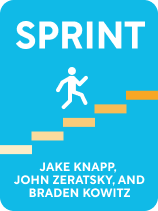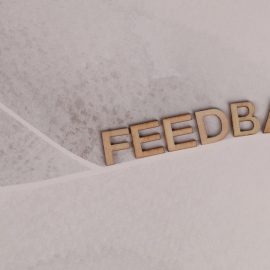

This article is an excerpt from the Shortform book guide to "Sprint" by Jake Knapp, John Zeratsky, and Braden Kowitz. Shortform has the world's best summaries and analyses of books you should be reading.
Like this article? Sign up for a free trial here.
Who should be part of your design sprint team? What is Jake Knapp’s advice?
According to Sprint author Jake Knapp, you can use a design sprint process with your team to build and test a prototype in just a five-day work week. Considering the size of your team and individual expertise are two of the priorities Knapp identifies for building your team.
Read on to learn Knapp’s advice for creating an ideal design sprint team.
Knapp’s Ideal Design Sprint Team
According to Sprint authors Jake Knapp, John Zeratsky, and Brian Kowitz, your design sprint team should have no more than seven members. Having more than seven hinders the decision-making process and makes it difficult to maintain the group’s attention. Start by picking two essential roles, which they call the Decider and the Facilitator. For clarity, we’ll call them the team leader and the sprint coordinator.
- Your team leader will have the final say on all major decisions in the design process. This should be someone with authority in your organization—someone from upper management or the person who is already the lead on the larger project your sprint falls under, for example.
- The sprint coordinator handles all the logistics of the sprint. They maintain the schedule and keep the team on task. They also moderate debates and record everything that’s said during group discussions.
When choosing the rest of your team, include designers and engineers who understand how your products are actually made. However, these shouldn’t be the only members of your team. People with other expertise—like a finance specialist who knows how a project is funded or a marketing associate who handles social media—can offer valuable context for the design process. The more diverse your team is, the more innovative solutions you’ll discover.
| Creating a Healthy Team Environment Here, the authors place great emphasis on finding specific members for your design sprint team and filling specific roles. However, in Smarter Faster Better, Charles Duhigg argues that selecting the individual members isn’t the most important factor for building an effective team. Rather, teams produce the best results when there’s an environment of psychological safety, regardless of who’s in the group and what their specific role is. All members of your team need to feel like they can share their ideas and opinions without facing the possibility of reproof or humiliation. Duhigg suggests you foster psychological safety in two ways. First, give all members of the team an equal amount of time to speak during group discussions to show that no single person’s input is more important than another’s. Second, practice social sensitivity by noticing and acknowledging the emotional cues of your team members, like body language and tone of voice. If you notice that a team member seems frustrated or hesitant about something, for example, encourage them to voice their feelings. This will show each individual that the team respects their emotions and opinions, and it will help you address points of conflict as they arise. |
Individual Expertise
Knapp advises that you organize short interviews with anyone who might have insights to offer on your project. The Sprint authors argue that no one person understands everything it takes to create and sell your product, so this time gives the whole design sprint team a chance to hear from every knowledge specialty represented at your company. By the end, every member of the team should have a well-rounded understanding of what’s involved in the development of your product. Through your questioning, the interviewees should close any gaps of knowledge about the project and point out places where the materials you developed earlier in the day can be improved.
| Advice on Seeking Advice How can you ask your (likely already busy) colleagues for their advice while being respectful of their time—and, how can you ensure the interview is a positive experience for them? Here are some tips on making the experience more pleasant, respectful, and valuable to your interviewees. First, when you approach a colleague you want to interview, ask them for their help using a positive, friendly tone to show you respect their expertise and their time. Be transparent about the amount of time your interview will take. Additionally, be clear about the kind of advice you’re seeking, and let the other person know what to expect during the interview. Tell them up-front that you’ll require their counsel on your team’s design problems. After the interview is done, make sure to thank the interviewees for their help. Send a follow-up email thanking them again the next day and keep them apprised of how you use their advice to improve your product. This will both show your appreciation and show them that their advice was valuable. |
Who to Interview
The authors recommend interviewing at least one person from inside or outside your design sprint team in each of the following spheres of expertise.
Your design sprint’s team leader. As a high-ranking member of your organization, they understand how the project fits into the context of your company’s larger plans. Their interview can help you refine your big-picture strategy as you move forward in the design process.
(Shortform note: If you’re the leader of your sprint team, help your team further understand the “why” of your project during your interview. Knowing the reasoning behind a project—what problem it will fix, who it will help, how it will benefit the company, and so on—can make the hard work of a sprint feel worth it because you’re working toward a bigger purpose. As the leader, you need to clearly demonstrate that you believe the project is worth pursuing. Your confidence will encourage enthusiasm in the other team members, helping your team to achieve success.)
Someone who has worked on the same project or a similar project before. They can offer information about past successes and failures, and they may already have solutions to some of the problems you’re trying to address.
(Shortform note: Use this interview to benefit from someone else’s failures in particular. Failure can be a great teacher. Past missteps give you important data not just about what didn’t work but also about why something didn’t work. This allows you to build off old ideas without making the same mistakes.)
People who understand how the different parts of the product work. This might include people who design the product’s components, people who market the product, or people who work on the technology involved—anyone who can help you understand how these different pieces make one cohesive whole.
(Shortform note: While Knapp, Zeratsky, and Kowitz stress the importance of gaining insight from all design sprint team members who understand the product, Cagan argues that designers and engineers have a unique understanding in this area: Product designers can answer questions about how your product will be unique to the user, what competing products exist, and how to ensure the product is enjoyable to use. Engineers create the coding and machinery of a product, so they can answer questions about its inner workings and the realistic scope of your project.)
Someone who frequently interacts with customers, like sales associates or customer service representatives. They can give insights into the real, everyday customer’s perspective and wants, not just those of an ideal customer. (Shortform note: Salespeople have the best understanding of customers’ wants and needs because their jobs depend on it. To be successful, they have to identify your product’s ideal customer and understand what problems your product solves for this customer. To do this, they have to constantly gather new information through outreach, surveys, interviews, and gatherings, so their knowledge of the customer is always evolving.)

———End of Preview———
Like what you just read? Read the rest of the world's best book summary and analysis of Jake Knapp, John Zeratsky, and Braden Kowitz's "Sprint" at Shortform.
Here's what you'll find in our full Sprint summary:
- How to build and test a prototype in just a five-day work week
- The step-by-step processes for planning and completing a sprint
- How to conduct one-on-one interviews with your customers






